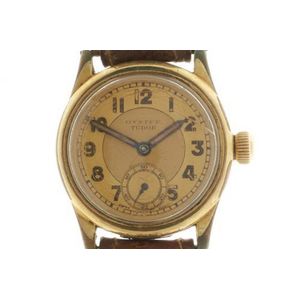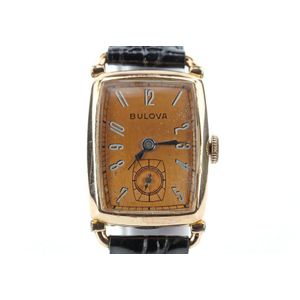Art Deco Bulova Wristwatch with Bronze Dial
You must be a subscriber, and be logged in to view price and dealer details.
Subscribe Now to view actual auction price for this item
When you subscribe, you have the option of setting the currency in which to display prices to $Au, $US, $NZ or Stg.
- Art Deco Period - The Art Deco period was a cultural movement that emerged in the 1920s and 1930s, and was characterized by its emphasis on modernism, luxury, and elegance. The name "Art Deco" comes from the Exposition Internationale des Arts Décoratifs et Industriels Modernes, a large exhibition held in Paris in 1925 that showcased the latest trends in decorative arts.
Art Deco was a reaction against the ornate and elaborate styles of the previous era, and reflected a new modern sensibility. It was characterized by streamlined, geometric shapes, bright colours, and the use of new materials such as chrome, glass, and Bakelite. Art Deco designers sought to create a sense of luxury and sophistication, often incorporating expensive materials such as ivory, marble, and rare woods.
Art Deco had a significant impact on a wide range of artistic fields, including architecture, fashion, graphic design, and interior design. Some of the most iconic examples of Art Deco architecture include the Empire State Building in New York City, the Hoover Building in London, and the Palais de Chaillot in Paris.
The Art Deco period came to an end in the 1940s, as World War II and changing cultural trends led to a shift in artistic styles. However, Art Deco remains an important influence on design and art, and continues to be celebrated for its modernist sensibility and glamorous aesthetic. - Bronze - An alloy of copper and tin, traditionally in the proportions of about 9 parts of copper to 1 part of tin.
The discovery of bronze in Western Asia in the 4th century enabled people to create metal objects which were superior to those previoulsy possible because of its strength and hardness, and it has been used throughout the world for weapons, coins, tools, statuary and other decorative items.
It is very fluid in a molten state, and its hardness, strength when set, and non-corrosive properties makes it most suitable for casting sculpture. - Movement - The technical name for the workings of a clock or watch, and does not include the dial or case.
This item has been included into following indexes:
Visually similar items

Jaeger LeCoultre Reverso Duetto Duo wrist watch; Ref: Q2691420 in 18ct gold, bezel set with sixty five round brilliant cut diamonds totalling 1.1cts, with silvered guilloche dial on a 854/1 calibre manual movement, back displays second time zone and day/ni

A vintage oyster Tudor wristwatch, 2 tone dial signed oyster Tudor, Arabic numerals, subsidiary seconds, case marked Oyster Watch Co, gold plated case and band worn, working, c.1940.

Cartier. A lady's 18ct gold rectangular wristwatch ref 2482 case 89947CE Tank Americaine circa 2010 Quartz movement, silvered dial, black painted Roman numerals, inner minute track, secret signature at VII, blued steel hands, sapphire set winding crown, ca

A gold ladies Tissot wristwatch. 18ct yellow gold, manual movement, marked Tissot, with small round case, silvered patterned dial with baton markers, two hands, fitted to a fine black leather strap
